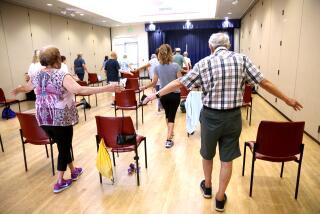Working 9 to 5 at Age 95
In Ellsworth, Maine, the phone rings on the desk of the editor of the Ellsworth American, a weekly newspaper. “Wiggins speaking,” the editor says, the same greeting he has used since 1922.
This is how he has approached each workday since his career began during the Harding administration. Why should anything change because he is 95 years old?
“I know very well if I didn’t have a job, many mornings I would say to hell with it and just stay in bed,” James Russell Wiggins explains.
Retirement strikes Wiggins as a ridiculous waste of labor and talent. “It’s sort of alarming to see men and women in their 60s, in full possession of their faculties,” lolling around retirement communities, giving in to lassitude, he says. “How can a society support such idleness?”
With his coat and tie and double hearing aids, Wiggins is among a growing number of nonagenarians who, by remaining in the work force, are both bucking one trend and setting another. According to social expectations, Wiggins and others in his age group should either be dead or in some retirement environment. They should be busying themselves with clever crafts projects and endlessly reminiscing, not looking forward. They should be surrounded by people their own age, comparing maladies.
But in an average month, 3.7% of people aged 90 or above--at least 50,000 people--were in this country’s work force. “Hard to believe that it’s true,” says Diane Herz of the U.S. Bureau of Labor Statistics, which had never assembled these figures before.
To its own surprise, the American Medical Assn. was able to identify at least 1,200 physicians age 90 and above who still see patients. The American Bar Assn. has never pulled such figures, but regularly receives calls wondering if this 97 year old or that 98 year old is the oldest living practicing attorney.
Architect Philip Johnson continues to design buildings at 92. New York society grande dame Brooke Astor remains a major philanthropic presence at 95. At 90, pianist Victor Borge is “going like 60,” a friend says. Martin Fireman, 94, has held the first violinist’s chair at the Brockton Symphony Orchestra, near Boston, since 1957. Sen. Strom Thurmond (R-S.C.) was 96 when he called to order the Senate impeachment trial of President Clinton.
While many Americans view work as drudgery, merely a means to a financial end, these nonagenarians share a passion for what they do. Many are self-employed, and most are in creative fields. Some find work a physical tonic, others regard it as a social responsibility. Regardless of stiff joints or failing eyesight, work for them remains a defining presence: “helpful and healthy,” says Wiggins, “and an agreeable predicament to be in.”
They are not without historical precedent. At 90, Oliver Wendell Holmes Jr. was still a spry U.S. Supreme Court justice. Walking down Pennsylvania Avenue one day, he spotted an attractive woman. “Oh, to be 70 again,” he said.
These nonagenarians presage the attitudes and expected actions of the next great wave of elderly Americans. A recent study by the American Assn. of Retired Persons found that 80% of baby boomers--now adults ages 35 to 53--expect to be working during what were once thought of as the retirement years.
Older Workers Fascinate Experts
Whether they are simply quirky, indomitable individuals or the vanguard of a new breed, this geriatric subgroup fascinates sociologists and demographers.
“It’s really important to start tracking these kind of late life, highly productive individuals,” says Helen Dennis, a specialist on retirement at USC’s Andrus School of Gerontology, because there’s every reason to believe there will be more of them to come. “What we see now as exceptional is going to become more mainstream,” Dennis predicts.
In her studies, Dennis has found they share a high expectation from life. They personify the “desire to have a highly fulfilled, meaningful life until you drop dead.”
This is also the conclusion of sociologist Theodore Roszak, who 30 years ago coined the term “counter culture.” Roszak’s new book, “America the Wise,” addresses what he calls “the longevity revolution,” in which Americans are viewing old age not as a time to lay fallow but as “a cultural and spiritual resource reclaimed from death by advances in public health and medical science in the same way the Dutch reclaim fertile land from the waste of the sea.”
Most people are content to stop working as they get older, and the Labor Department calculates an average retirement age of 62--against a life expectancy of 76.1 years. Many others are unable to work, especially as they become very old. But among those who follow this country’s conventional path of retirement, more and more people, says Roszak, are “growing restless with a life limited to the card table and the golf course.”
She’s Working at Avoiding Retirement
Surrounded by bolts of fine silk, with chandeliers dangling from every conceivable inch of ceiling space in her Manhattan business, Ruth Vitow says there is no chance, no prayer, that she would trade the custom lampshade business she founded more than 60 years ago for a card table in sunny Florida.
“Deadly!” she insists. “I’d hate it.”
Unlike some of her contemporaries who have fled for golf courses in Arizona and high-rise condos in Florida, she has made the decision to stay put.
After working together for more than 40 years, Vitow and her younger sister, Elizabeth Sampson, do not disclose their ages. But suffice it to say they qualify for an article about nonagenarians in the work force.
On a recent workday, Vitow wears a handsome platinum-blond wig and a fashionable knit dress. Sampson, runway-model thin, greets clients in a deep blue sweater and skirt, matching blue stockings and shoes and a chic chestnut wig.
Together they preside over a small empire that began when Vitow was unable to find a satisfactory lampshade for her own home, 60-plus years and assorted husbands ago. Applying the techniques she learned while working for legendary hat designer Lily Dasche, she fashioned her own. The day she opened Ruth Vitow Inc., “we were flooded,” she recalls. “It’s been that way ever since.”
At that moment, the door of Vitow’s studio-showroom bursts open to reveal a well-known-decorator clutching a 6-foot-tall lamp. Vitow, more than a foot shorter, stands on a chair to study the shadeless object, much like a very short brain surgeon examining a very tall patient.
“Something with fringe?” the decorator asks hopefully.
“No fringe!” Vitow decrees.
Well-intentioned friends and family members often ask Vitow when she plans to give up her business. She replies: “When it gives me up.”
Twenty blocks away, Dr. James R. Dumpson, “Dr. D.,” as many people call him, is busy reviewing funding proposals for the New York Community Trust, the nation’s largest community foundation. He celebrated his 90th birthday on April 5.
He oversees grants involving health and welfare, education, the arts, medicine, “basically the spectrum of human activity.” In addition, he sits on “I don’t know how many boards, six or eight?” He also teaches social work at Fordham University. Dumpson earned his own doctorate at the University of East Pakistan while working for the United Nations.
Retirement, he insists, “is not an item on my agenda.”
An opera buff, Dumpson goes to the Met at least once a month. Recently he embarked on a two-week trip to Ghana with a group he belongs to, the Black Agency Executives. He is long since separated, though Dumpson often visits his wife in Honolulu. His daughter is a psychotherapist, and Dumpson has forgotten how old she is.
“I never think about her age. I just think about what she’s doing,” he says.
Dumpson is often asked why he is still working. “I tell people, ‘you know aging is a privilege, and for every privilege it seems to me that there is a responsibility that goes along with it.’ My responsibility is to keep sharing whatever opportunities I have to give back to communities.”
“Actually,” he continues, “working helps me in terms of my mental outlook, and in terms of my physical well-being. I keep connected to human needs, and therefore to what I can do to contribute to enriching peoples’ lives. And in doing it for someone else, I am doing it for myself also. There’s a little selfishness in that, too.”
Without an office to go to, without the stimulation of colleagues, “I probably wouldn’t be in such good health,” Dumpson says. “I’d be home thinking, what’s aching today, and wondering what medicine should I take. I don’t think about those things.”
Work Is Play for Some Seniors
“Who snookered the world about retirement, anyway?” he wonders.
(That distinction largely falls to Prince Otto von Bismarck who, in addition to unifying Germany, in the 1870s introduced age 65 as the age at which workers could quit and get a pension.)
While he continues to perform around the world, Victor Borge marvels that “it takes a long time to get to be 90, but when you are there, it seems as if it happened very fast.”
More and more, Borge spends time at home in Greenwich, Conn., where his wife is very ill. Yet when he is performing, “I play better than I ever played before. I play better because I pay more attention. I have more attention.” Similarly, says Borge, “I walk slower but I see more.”
To read, or when he is rehearsing for concerts, Borge wears special triple glasses, the kind a surgeon uses. He has little use for the idea that turning 90 makes him some kind of fascinating historical relic.
“I don’t know what other people do when they are 90. I know what I do,” he says. “I feel that I have never been real old, and I am not yet real old.”
Famous largely among Los Angeles-area retirement home audiences, singer-actor Ida Engel did not really begin her career as an entertainer until five years ago, when she was 90. That was the year she appeared in a small, well-received documentary film, “Young at Hearts.”
Engel got the bug, and soon she signed up for a senior citizens’ commercial acting class. An agent spotted her picture, and better yet, heard her huge and infectious laugh. Soon she was appearing in television commercials, most recently for Holiday Inn.
“Now I go for auditions regularly,” she says, “and in the last couple of years, they’ve been calling me often. I seem to get callbacks quite a bit.”
Engel, a widow, was well paid for the five days she worked on the Holiday Inn spot, $500 a day. “Now I also get these, what do you call it?, these nice checks for residuals--yes, that’s it, residuals.”
Working at her age is unusual, says Engel, who also sings in a community vocal group, the Chansonettes: “But, oh, I love it. That’s why I’m still alive. I am entertaining, and I’m enjoying people too. I really have a lot of fun.”
To Pulitzer Prize-winning poet Stanley Kunitz, savoring life each day at 93 “seems to me miraculous, beyond anything that one could expect.”
“I think ‘retire’ is an ugly word,” adds Kunitz, whose most recent collection was titled “Passing Through.”
In his lower Manhattan apartment, Kunitz keeps night-owl hours, writing, editing and reading when most of the world is asleep. In the summers, when he and his artist wife, Elise Asher, relocate to Cape Cod, Kunitz follows the schedule of his beloved garden.
“Aside from giving me a sense of the cycle of repeated life and death, and the beauty of the flowering world, it gives me the greatest exercise, too,” he says. “I’m sure the immersion in that garden has enhanced my life. I look at the garden, and I see that the opportunity for change is always there, as it is in life. One has to be ruthless: in a garden, one gets rid of the failures. It’s the same with poetry.”
Kunitz has a muse, his “secret agent within,” that tells him when a poem is ready. Until the words emerge, “I’m always thinking about possibilities, and digging a little deeper, trying to find a rhythm that belongs to that specific conjunction of time and space and imagination.” It is what he has done since boyhood, since he was too young to realize that embarking on a life of poetry took guts, not to mention a potential affection for poverty.
“As one gets older,” he says, “obviously some of that early impetus, that glandular compulsion is no longer present. One has to dig for those poems, and the older one gets, the deeper one has to go.” Now there is a new urgency, says Kunitz. “Time is at one’s heels, certainly. There is a sense of wanting to say whatever one has left to say.”
But what also keeps this poet working is “an absolutely irresistible desire to know what is going on in the world, and to be a part of it.” Besides, marvels Kunitz, “how can one retire from poetry? Poetry is life.”
At the Ellsworth American, editor Wiggins himself writes a weekly poem along with his regular column. Around this coastal village, Wiggins is known as the Energizer Editor: He just keeps going and going. He relocated to Maine in 1969, after serving as U.S. ambassador to the United Nations, editor of the Washington Post and working for a half-dozen other newspapers. A widower, he still lives in the Federal-period home he and his family vacationed in for more than a half-century. He composes his copy on a standard typewriter.
Wiggins concedes, “not everybody’s work is rewarding.” His own enthusiasm is fueled by his belief that “working for a newspaper of any size is fun.” He also firmly maintains that “routine is the salvation for old age.” A structured workday, Wiggins acknowledges, probably has enhanced his longevity.
Wiggins quit driving three years ago, and a young man now drives him to and from work. “My family said that if someone ran into me, broadside, they would say ‘that stupid old man collided with me.’ ” Another casualty of old age: attending parties and realizing he is the oldest one there.
“It’s one of the prices you pay for getting old,” he says. “You watch your companions drop off. It’s like walking across a field of land mines. They drop off, you stay.”
Of course the world asks him, will you ever retire?
“Well, I’ve got to think about that,” is Wiggins’ standard reply.
There is a pause, then a smile, then this riposte:
“Probably not.”
More to Read
Sign up for Essential California
The most important California stories and recommendations in your inbox every morning.
You may occasionally receive promotional content from the Los Angeles Times.










